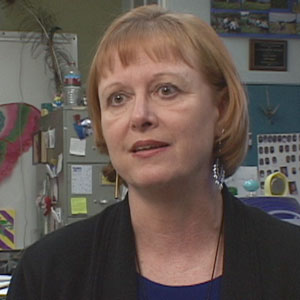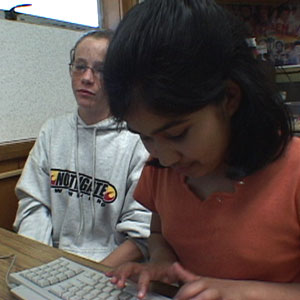Join us for conversations that inspire, recognize, and encourage innovation and best practices in the education profession.
Available on Apple Podcasts, Spotify, Google Podcasts, and more.
 “I think it’s really hard to learn something new — just phenomenally hard to learn a concept that you’ve never been introduced to before and then to be tested on it. And to have some compassion and respect for what it is that we’re asking these kids to do on a daily basis is very important. So my philosophy is simple. It’s hard to learn, and it’s my job to bring as many ideas and facets to a lesson as I can. It needs to be visual, it needs to be oral, it needs to be kinetic. I need to get those kids any way I can, and I need to really respect what they’re doing.”
“I think it’s really hard to learn something new — just phenomenally hard to learn a concept that you’ve never been introduced to before and then to be tested on it. And to have some compassion and respect for what it is that we’re asking these kids to do on a daily basis is very important. So my philosophy is simple. It’s hard to learn, and it’s my job to bring as many ideas and facets to a lesson as I can. It needs to be visual, it needs to be oral, it needs to be kinetic. I need to get those kids any way I can, and I need to really respect what they’re doing.”
“I just dig the kids at this age. For the most part, they’re like sponges and they’re excited — they jump and learn — and for a lot of them, this is the first time they’ve really had any science education at all. My goal is to move my kids as far as I possibly can in the short amount of time I’ve got, to try to impart as much knowledge as I can, and to have learning be as exciting as it can possibly be.”
Ariel Owen and Jeff Parrish teach 6th-grade science at the Foothill Middle School in Walnut Creek, California. Ariel started teaching after a career in office management at large real estate and retail organizations — “I was good at it, but it was very boring,” she comments. So she returned to school, earned her degree in education, and started teaching science. “What I really like,” says Ariel, “is working in something where I get immediate results, and feel like I’m making a good contribution to what’s happening with my future and with theirs.”
Jeff attended the University of California at Berkeley, where he majored in biological field science and planned to go to dental school, but jokes that he realized it was more his mom’s idea than his own. After returning from Vietnam, Jeff returned to school to get certified, and has been in the classroom ever since — an impressive 32 years. Though not formally teamed, Jeff and Ariel are the only 6th-grade science teachers at Foothill, and they work together closely, following approximately the same lesson plans and freely exchanging ideas.
Recently, both have been working with an online, inquiry-based curriculum called WISE, which was developed through a partnership between the education department at UC Berkeley and the Concord Consortium. Both teachers agree that a major strength of using computers for science education is that it gives the students unique opportunities to model scientific processes. “At this age,” says Jeff, “students are very literal. Being able to show them computerized models rather than just a stagnant page in a book is a big help to them when they’re trying to understand a concept.” Ariel adds, “When my students are working on this, they are utterly engaged — talking to each other, reading, making entries on their computers… they’re excited about what they’re learning.”
 Lesson at a Glance:
Lesson at a Glance:
Curriculum: WISE
Grade: Sixth
Topic: Plate Tectonics
For the lesson in the video, Ariel and Jeff had their students continue working on a two-week tectonic plate unit from the web-based, inquiry science environment WISE. The lesson began with the children at their computers answering broad questions about what they know about topics related to plate tectonics, such as mountains, volcanoes, and earthquakes. After recording their thoughts and completing additional explorations into plate tectonics, the students used the computers to create models of plate interactions and also to record explanations of their models.
Ariel explained that at that point in the lesson her job was to have her students justify their models and explain their decisions to her. When the models were complete, the students in Ariel’s and Jeff’s classes exchanged their work and, as a class, critiqued the other class’s models and explanations. “When students are looking at peer models and evaluating them,” explained Ariel, “what they’re thinking is, ‘Is mine as good as theirs, or is theirs better?’ So they’re not just doing an evaluation. They’re also doing self-assessment.” The next step in the lesson was for the children to revise their models before they learned more about plate interactions.
Both Ariel and Jeff feel strongly about the efficacy of a computer-based inquiry environment for science education. “The difference between computer learning and a book is the interactive part,” explains Jeff. “It is really neat to be able to show them how to take the Earth and twist it so that you can see everything that’s going on inside that relates to events that are occurring on the surface… It’s a very visual way of presenting what happens on the planet, and why things occur and I wouldn ’t trade it for anything.”
“What’s On Your Plate?”, the activity depicted in the video, was developed by Concord Consortium as part of the “Making Thinking Visible” project, funded by the National Science Foundation under grant No. REC-9980600, Dr. Janice Gobert, Principal Investigator. WISE (“Web Integrated Science Environment”) is funded by the National Science Foundation (REC- 0128062), Dr. Marcia Linn, Principal Investigator, UC-Berkeley. Any opinions, findings, and conclusions expressed are those of the authors and do not necessarily reflect the views of the National Science Foundation.`